Disclosure: Meeple Mountain received a free copy of this product in exchange for an honest, unbiased review. This review is not intended to be an endorsement.
Messrs. Ben Pinchback and Matt Riddle are whizzes at roll and write games. Their previous efforts, Fleet: The Dice Game and Three Sisters, are top tier titles in this rapidly growing subgenre. So when I was asked if I wanted to take a look at the next release, titled Motor City (which brought in a 3rd co-designer, Adam Hill), I quickly agreed. I don’t have a particular interest in car games, but let’s fire up the engines, take Motor City out on the test track, and put the pedal down.
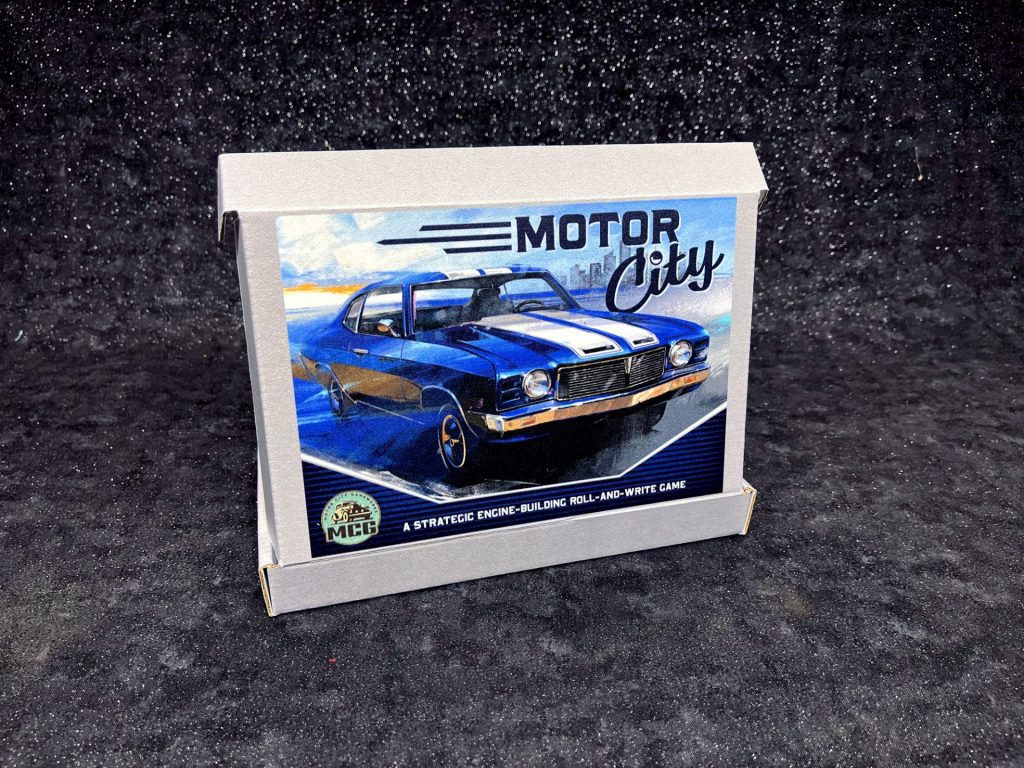
Reluctantly crouched at the starting line
If you’ve played either of the two previously mentioned games, you’ll be in familiar territory. Motor City comes with a set of multi-colored dice, a Blueprint board, and two pads of scoring sheets (players receive one of each sheet).
The first thing you’ll notice is that Motor City is dense with information: the nine distinct areas of attention (across both scoring sheets) contain boxes, circles, octagons, and so many icons. It’s a bit overwhelming at first glance. But thankfully the rules are pretty well written and provide both prose descriptions and illustrations of each section, with lots of examples.
Setup takes seconds: pull out the correct number of dice for your player count (from 1 to 4), give each player one sheet from each pad, and make sure everyone has their preferred marking device (something with an eraser is going to work best here), and you can start the game.
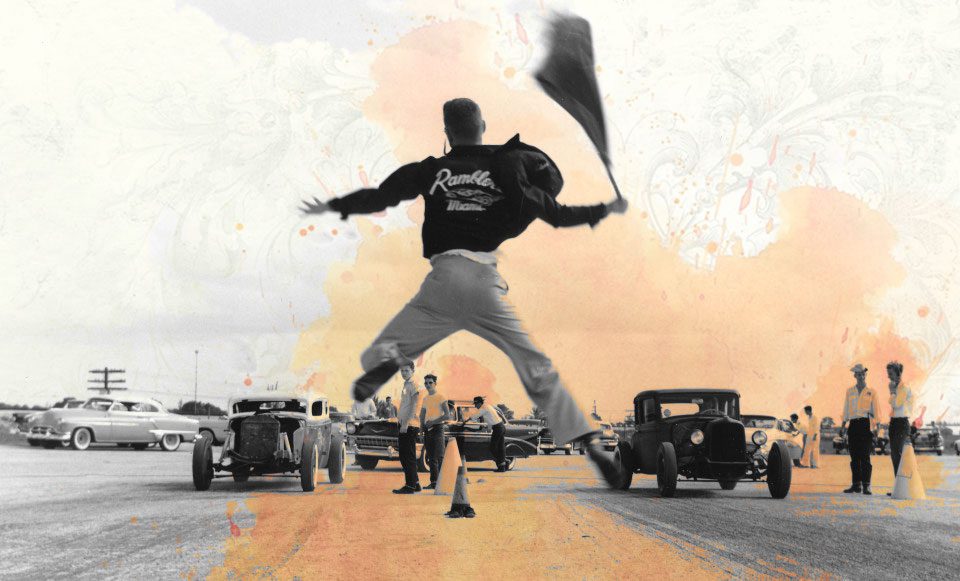
The green light flashes, the flags go up
Turns in Motor City are broken into 3 phases:
The Planning Phase
In which the active player rolls all the dice, and places them into their spots on the Blueprint board.
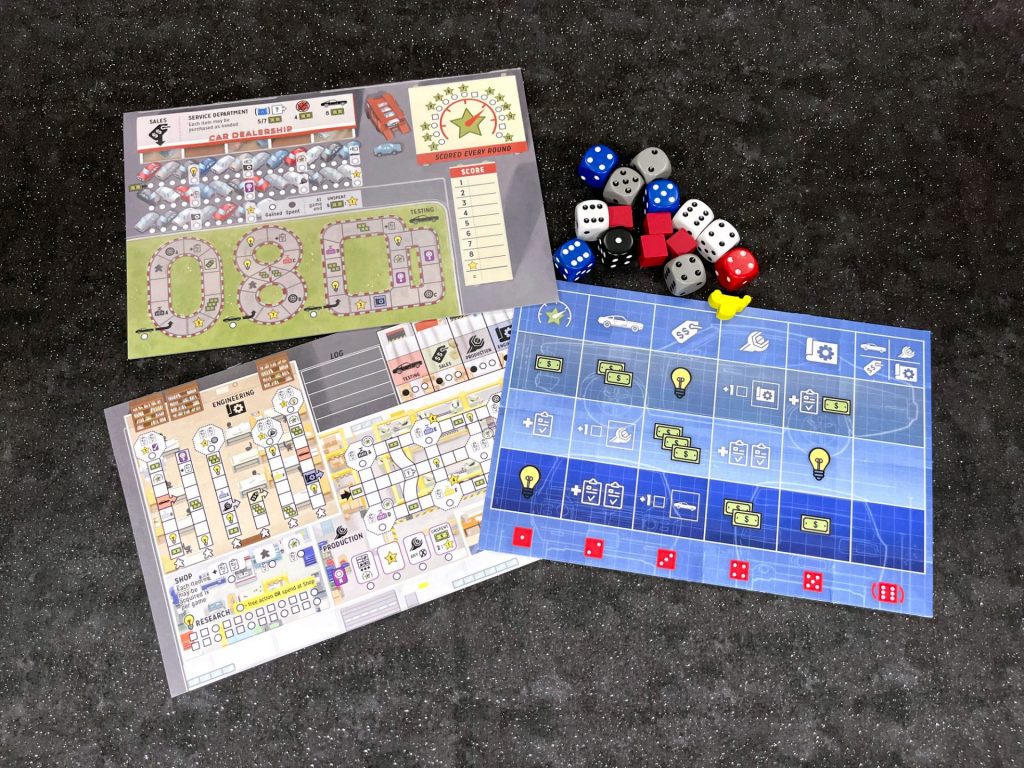
The Industry Phase
Players take turns selecting dice from the Blueprint board. They then take the following actions, in order:
- Bonus – If the space containing your chosen die has a bonus printed on the space, then collect it.
- Select one of the following actions:
- Take the Blueprint Action – shown at the top of the column (more on those actions in a moment).
- Upgrade – the Blueprint action shown at the top of the column.
- Perform research – check off the next box in the research section of the scoring sheet. This section provides valuable bonuses and combo possibilities.
- Scoresheet Action – Place your selected die into an unoccupied action space on your scoresheet and take the associated action.
Blueprint / Scoresheet Actions
This was one of the more confusing things that we encountered in our first few games. When selecting your die you get to perform a Blueprint Action. And when placing that die onto your scoresheet you get to perform a Scoresheet Action. But these actions pull from the same pool and you can even perform the same action twice. Additionally, each of these actions can be upgraded to make them more powerful. So let’s run through these to help prevent confusion.
Looking at the Blueprint board, from left to right, the actions are:
- Speedometer – Increase the current level of your speedometer. At the end of each round, mark the current value of the speedometer as points for that round. This can account for a third of your points.
- Testing – Mark off spaces on a single, active, testing track equal to your current Testing level. Earn any bonuses you mark off.
- Sales – Mark off spaces on the sales track equal to your current Sales level. Earn any bonuses you mark off.
- Production – Mark off spaces on the production track equal to your current Production level. Earn any bonuses you mark off.
- Engineering – Mark off spaces on a single, active, engineering track equal to your current Engineering level. Earn any bonuses you mark off.
Audit Phase
In Motor City, as in life, there are things that may get in the way of you accomplishing your goals. In Motor City we have the Auditor. This is a red die which gets rolled during this phase, then placed at the bottom of the Blueprint board. Each player places a red cube onto their scoring sheet, covering the action matching the red die. In the following round, players will not be able to take that Scoresheet Action, but will still be able to take the Blueprint Action (a bit confusing, no?).
Players also mark the current value of their Speedometer into the round tracker on their scoresheet. Pass the player marker and repeat until the end of the 8th round.
As they speed through the finish, the flags go down
At the end of the 8th round, players tally their points from the speedometer track, along with any star bonuses earned from the Production, Engineering, Sales, and Testing tracks. Finally, players add up points from Certifications, as well as any end-game bonuses.
The player with the most points wins the game.
He’s racing and pacing and plotting the course
Motor City has a lot to offer for the discerning gamer: thinky choices that require long term planning and committing to a path, short term tactical decisions that allow you to take advantage of the current game state, and a solid theme. Even though I’m not a car guy, it feels like it represents the auto industry pretty well at a high level. One person called it Kanban Roll & Write, and I think that name fits pretty well: the actions range from designing and producing the car, to testing and selling it.
As mentioned previously, there are nine sections of the board, and you won’t be able to ignore any of them. If you want to get ahead in Engineering you’re going to want to spend time in Testing so you can open up new Engineering tracks. If you want to earn those valuable Certifications then you’ll need to push hard in Sales. Everything is interconnected in Motor City which leads to my favorite part of the game: combo chaining.
In true Pinchback and Riddle fashion, the combo chaining in Motor City is next level. Clever thinkers can rack up multiple bonus actions in a single turn and make great strides off a single die. Here’s an example:
Take a Blueprint board bonus action and get $3 on the Sales track, which gives you a single extra marked space in the Testing track. That Testing track space checks off a Research icon which allows you to earn a Bonus action anywhere on the board, at that area’s current level. Take that bonus action and move along the Engineering track and earn a Production level upgrade. And that’s just from the bonus taken from the Blueprint board. You still have the actual Blueprint Action and Scoresheet actions to take that turn.
Motor City rewards players who can think several turns ahead and can keep complex systems in their mind—twisting and turning them to achieve maximum efficiency. Unfortunately, that’s not me.
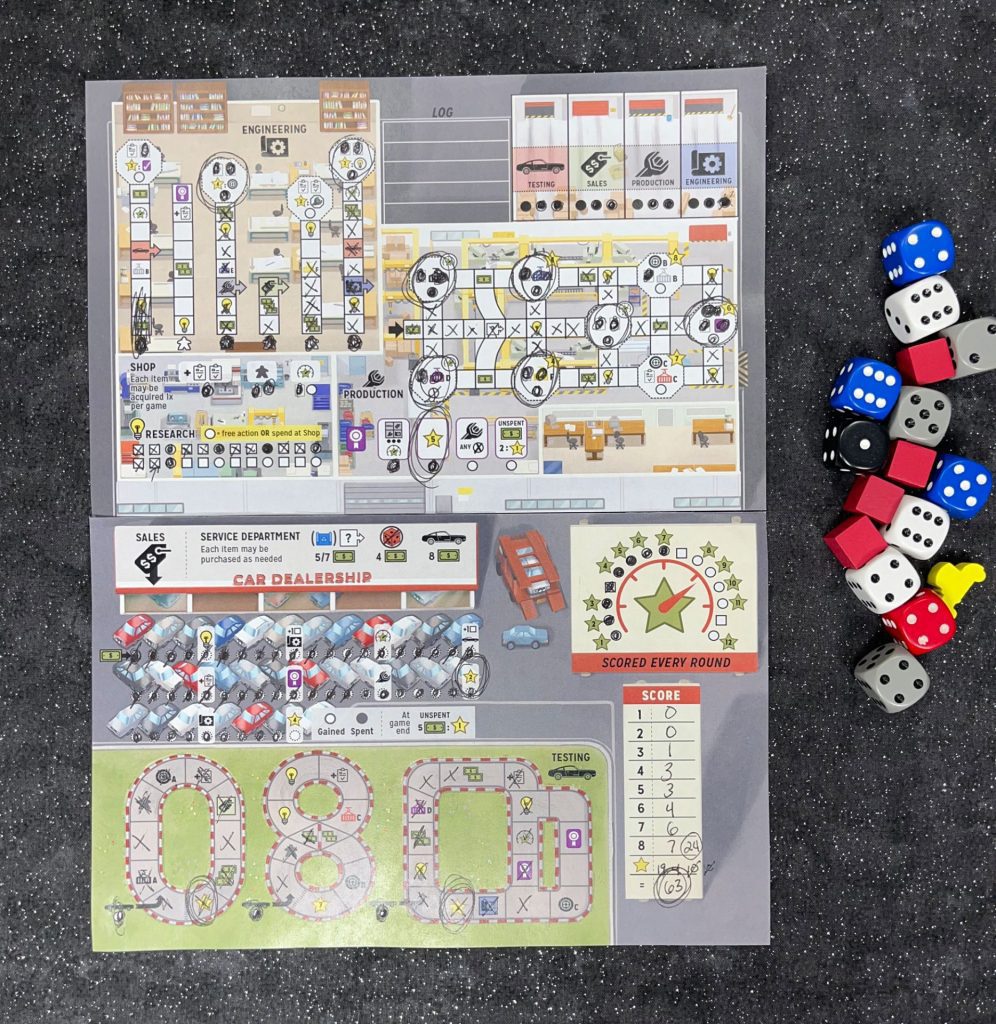
He’s driving and striving and hugging the turns
So what did I think of Motor City? It’s not my favorite, and let me tell you why.
The threshold for what is considered a “heavy” game is a personal one. Some might think Ticket to Ride is heavy, as I did the first time I played it many years ago. Others might play much heavier strategy games as a matter of course and shrug off notions of complexity. Motor City is definitely on the upper end of the heaviness scale, at least from what I’m used to in a roll and write. There are so many options, and many more objectives to keep in mind. It can be tough to juggle all of those and still feel like you’ve accomplished something meaningful in the span of only 8 turns.
The thing that stands out the most to me are the “achievements.” I’m not sure if the designers have a collective name for this, so I’ll use that term for now. These are lettered icons scattered throughout the score sheets that you must collect in order to reap rewards located on other parts of the scoresheet. Here’s an example: on the figure 8 Testing track is the C shipping container. That container, along with the C tire, and a single TPS report, must be collected before the 7 point Production hub can be scored; and that’s assuming you’ve progressed to that point on the Production track.

I can’t fault the designers for this, it’s a common board game mechanism, requiring multiple dependencies and turns to achieve a scoring condition. But for some reason it bounced off me in Motor City. Perhaps it’s the way they’ve positioned them, or the quantity, but it’s fairly difficult to achieve some of these conditions; requiring you to move along multiple tracks, in opposing directions. It really takes their previous games and adds this new element to them, ratcheting up the complexity. But that’s just not for me.
There’s also some issues with sizing. As mentioned earlier, this game has lots of information, and it’s all pretty crowded together. I know Adam, Ben, and Matt are trying to balance size with cost, but I think this one could benefit from a size increase, if for no other reason than to make it more legible and easier to play.
Long ago somebody left with the cup
I love Matt and Ben’s previous work in this space. I always tell people that Fleet: The Dice Game is my “gold standard” for roll and writes. Three Sisters took that same skeleton and layered on a wonderful theme which felt immersive. Motor City has the same DNA as both these other games, with a powerful chassis and a snazzy paint job. It also injects some additional resource gathering elements that require more from players than either of those other games. But if Motor City is a 1964 Pontiac GTO muscle car, I’ll just stick with my 1961 Lincoln Continental sedan.
So if you’re looking for the next roll and write challenge, or if you’re particularly into car games, then head out on the highway and keep an eye out for Motor City, coming soon to Kickstarter.







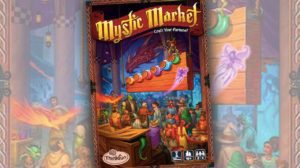




Love that song 🙂